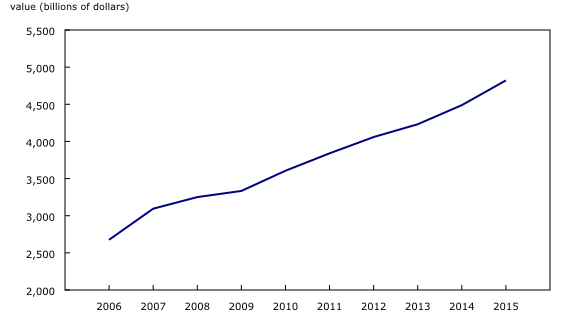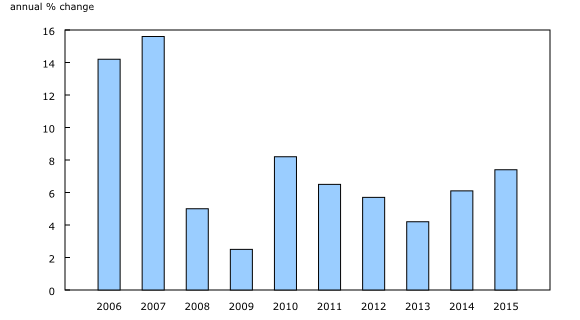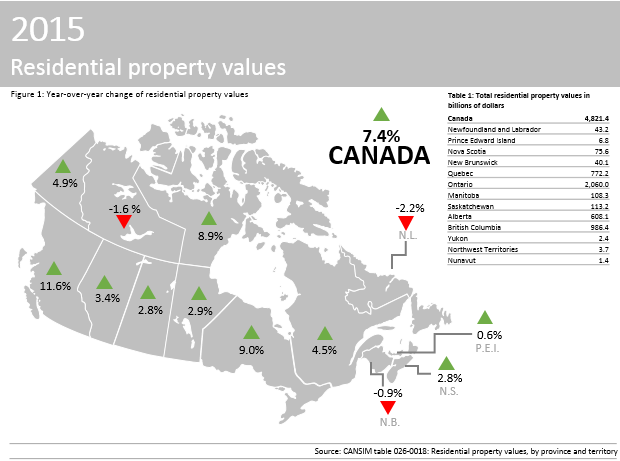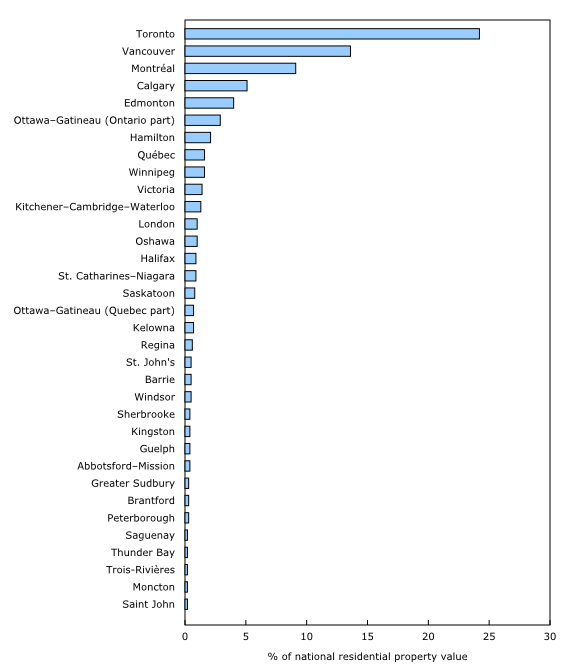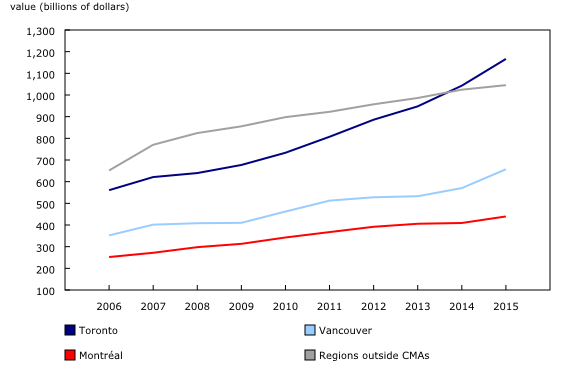Residential property values, 2015
Archived Content
Information identified as archived is provided for reference, research or recordkeeping purposes. It is not subject to the Government of Canada Web Standards and has not been altered or updated since it was archived. Please "contact us" to request a format other than those available.
Released: 2018-05-09
$4,821 billion
2015
7.4% 
(annual change)
The total value of residential properties in Canada was $4.8 trillion in 2015, up 7.4% from 2014. The total value has risen 80.2% since 2006.
Residential property values concentrated in four provinces
In 2015, four provinces accounted for more than 90% of total national residential property values: Ontario (42.7%), British Columbia (20.5%), Quebec (16.0%) and Alberta (12.6%).
These four provinces accounted for 98.0% (+$325.9 billion) of the total national annual increase, led by Ontario (+$170.3 billion) and British Columbia (+$102.3 billion). Residential property values increased 11.6% year over year in British Columbia and 9.0% in Ontario, more than double the increase reported in Quebec (+4.5%) or Alberta (+3.4%).
Toronto, Vancouver and Montréal account for almost half of total residential property values
The census metropolitan areas (CMAs) of Toronto ($1,166.5 billion), Vancouver ($657.2 billion) and Montréal ($439.4 billion) constituted 46.9% of total property value in 2015.
Together, CMAs accounted for $3.8 trillion in 2015, representing over three-quarters (78.3%) of total residential property values.
On a year-over-year basis, residential property values increased by 9.0% in 2015, while regions outside CMAs rose by 2.0%.
The largest residential property value increases were found in Oshawa (+15.6%), Vancouver (+15.2%), Kitchener–Cambridge–Waterloo (+11.8%), Toronto (+11.8%) and Hamilton (+10.5%).
Residential property value in Toronto surpassed the total value for all regions outside CMAs in Canada for the first time in 2014 and extended its lead in 2015.
Toronto accounted for over one-third (37.1%) of the total annual Canadian residential property value increase, while Vancouver represented just over one-quarter (26.1%) and Montréal 9.1%.
Since 2011, residential property value in Toronto has grown at a quicker pace than in Montréal and Vancouver. However, from 2014 to 2015, Vancouver reported the largest year-over-year increase compared with either Toronto or Montréal.
Note to readers
Estimates of total residential property values, by province, territory and census metropolitan area (CMA), are now available for reference years 2014 and 2015, and revised estimates are available for reference years 2009 to 2013. These estimates are subject to revision as more current assessment and auxiliary data become available.
Residential property includes all types of property categorized as residential in most provinces in the context of assessment for property tax purposes. It includes single- and multi-family properties, farm residences, cottages and vacation homes, mobile homes, institutional and communal residences and vacant land for residential purposes.
Property values refer to the values of properties determined by the provinces, territories and municipalities using a specific property assessment approach (cost, sales comparison or income) and adjusted by Statistics Canada to target price and volume dates of the reference year. For a given reference year, the target price date is July 1 and the volume state date is December 31. For example, in reference year 2015, the price of properties is as of July 1, 2015, and the stock or volume is as of December 31, 2015.
For the purpose of this release, the census metropolitan area of Ottawa–Gatineau (Ontario and Quebec) is divided into two areas: Ottawa part and Gatineau part.
The methodology used in this release differs from that used in the release on "Residential and non-residential property assessment values" (see record 5191 published in The Daily on November 22, 2017). The values in this release represent taxable and exempt residential property values, expressed according to the reference year. However, for the purpose of Finance Canada's fiscal arrangements, values in record 5191 represent the taxable portion of residential and non-residential property values, expressed according to their taxation year, which corresponds to the year following the value's reference year.
Contact information
For more information, or to enquire about the concepts, methods or data quality of this release, contact us (toll-free 1-800-263-1136; 514-283-8300; STATCAN.infostats-infostats.STATCAN@canada.ca) or Media Relations (613-951-4636; STATCAN.mediahotline-ligneinfomedias.STATCAN@canada.ca).
- Date modified:


